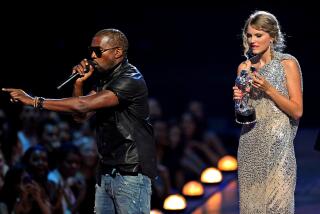Review: Bob Stanley’s ‘Yeah! Yeah! Yeah!’ is crazy in love with pop music

In 1954, Bill Haley shook, rattled and rolled. In 2003, Beyoncé went crazy in love. That’s two pop stars, among the biggest of their time, using similar language (and similar grooves) to describe more or less the same thing.
But think of all that happened over the half-century that separates them: Elvis Presley, rockabilly, “Why Do Fools Fall in Love,” girl groups, the Beatles, the Rolling Stones, “Like a Rolling Stone,” Motown, the Beach Boys, the singer-songwriter, punk, disco, heavy metal, “Hotel California,” new wave, New Order and new jack swing. And Madonna! And country music! And “We Are the World”!
This absurdly, deliriously vast landscape is what Bob Stanley sets out to map in his sweeping but finely detailed new book, “Yeah! Yeah! Yeah! The Story of Pop Music From Bill Haley to Beyoncé.” And though one of his central points is that credentials rarely matter in pop — which, by the way, he defines usefully as music made for “an audience that the artist doesn’t know personally” — Stanley’s background ensures that he comes to the job adequately equipped.
Familiar to record nerds from his role in the curatorial British trio Saint Etienne (which broke out in the early ‘90s with a moody electro-house rendition of Neil Young’s “Only Love Can Break Your Heart”), he also worked as a writer for NME and Melody Maker during those U.K. music papers’ late-’80s glory days. So he’s a studio rat capable of explaining the mechanics of dub reggae as well as a critic unafraid — overjoyed, really — to declare that the Stones “were indirectly responsible for some of the worst aspects of modern pop.” Passion, skepticism and technical know-how — these are the engines of Stanley’s work.
And does he ever put some miles on them. Structured chronologically, “Yeah! Yeah! Yeah!” moves crisply but methodically through history as the author takes up each successive scene or sound or movement and tries to understand its place in the larger story — just how, for instance, it was that the “scrunched-up tinfoil” sound of mid-’50s English skiffle gave way to the melodic and textural invention of John Lennon and Paul McCartney.
Think of the book as an encyclopedia in narrative form, one shaped by the author’s subjective, sometimes contrarian taste. (His favorite Bob Dylan record: “New Morning.”)
Crucially for a volume stuffed with as many proper nouns as this one, Stanley is strong with description: Presley’s “Hound Dog” is “two minutes of sustained viciousness and sheer malicious glee”; Van Morrison has a “ruddy, sponge-pudding face.” He’s got loads of trivia too: I, for one, never knew that Elton John made money early on by singing covers of current hits for cheapo supermarket compilations. “His recording of Bob and Marcia’s ‘Young, Gifted and Black,’” Stanley notes, “was quite something.”
But in an age when virtually all of this information is readily available to any reader with a smartphone — the facts and figures on Wikipedia, the thousands of songs themselves on Spotify — Stanley is best when he steps outside the march of progress and considers the whys and wherefores silently embedded in the music.
Writing about the British Invasion, he wonders if the sudden influx of U.K. acts can be attributed to America’s having “lost faith in itself” after the Kennedy assassination. And he decides that, despite its commercial success, Motown was dismissed by many critics at the time because the label wasn’t “firming up the values of its own local community.” That, he adds, “is how a lot of (usually white) purists, from Alan Lomax to Peter Guralnick, like their black music.”
A creative who’s also worked on the other side of the business as a label owner, Stanley digs too into the rise of music’s ancillary industries, such as the pop press (“consumers wanted … to feel closer to their idols,” he writes) and music-based television programming like the BBC’s hugely influential “Top of the Pops,” which aired from 1964 to 2006.
Indeed, “Yeah! Yeah! Yeah!” concludes — it had to end somewhere — with the advent in 2003 of another industrial shift, from physical product to downloads and streaming. Like many lifelong record collectors (and nearly all professional musicians), Stanley seems troubled by the digital era’s decontextualizing free-for-all.
“Without the detail, pop music doesn’t have the desirability it once had; it’s not as wantable,” he writes.
Yet you never get the impression that he’s stopped listening. As clear-eyed about music as he is crazy in love with it, he’s easy to picture scrolling through the iTunes Store, clicking on the No. 1s along with the obscurities, taking notes perhaps for a second volume: “The Story of Pop Music From Beyoncé to ….” Well, who knows?
Twitter: @mikaelwood
Yeah! Yeah! Yeah!
The Story of Pop Music From Bill Haley to Beyoncé
Bob Stanley
W.W. Norton: 599 pp., $29.95
More to Read
Sign up for our Book Club newsletter
Get the latest news, events and more from the Los Angeles Times Book Club, and help us get L.A. reading and talking.
You may occasionally receive promotional content from the Los Angeles Times.








